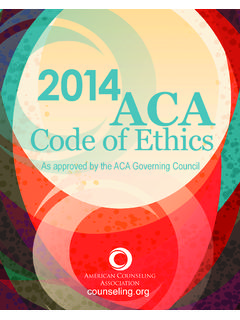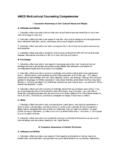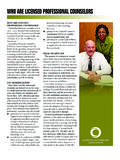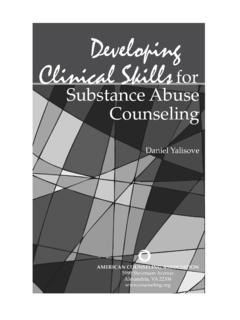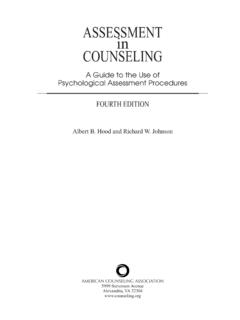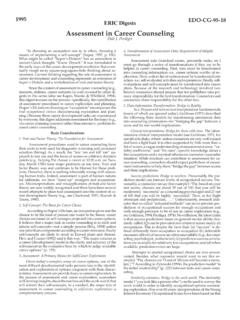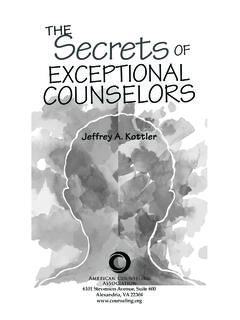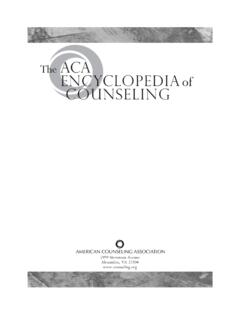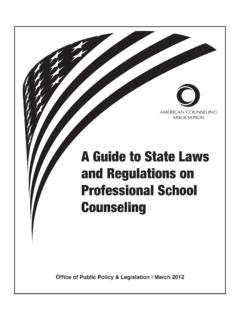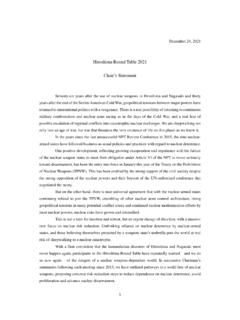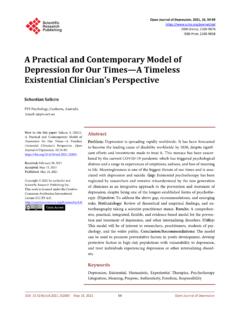Transcription of When Treatment Becomes Trauma: Defining, Preventing, …
1 Suggested APA style reference information can be found at Article 73 when Treatment Becomes trauma : defining , preventing , and Transforming Medical trauma Paper based on a program presented at the 2013 American Counseling Association Conference, March 24, Cincinnati, OH. Michelle Flaum Hall and Scott E. Hall Flaum Hall, Michelle, is an assistant professor in Counseling at Xavier University and has written and presented on the topic of medical trauma , post-traumatic growth, and wellness for nine years. Hall, Scott E., is an associate professor in Counselor Education and Human Services at the University of Dayton and has written and presented on trauma , depression, growth, and wellness for 18 years.
2 Abstract Medical trauma , while not a common term in the lexicon of the health professions, is a phenomenon that deserves the attention of mental and physical healthcare providers. trauma experienced as a result of medical procedures, illnesses, and hospital stays can have lasting effects. Those who experience medical trauma can develop clinically significant reactions such as PTSD, anxiety, depression, complicated grief, and somatic complaints. In addition to clinical disorders, secondary crises including developmental, physical, existential, relational, occupational, spiritual, and of self can lead people to seek counseling for ongoing support, growth, and healing.
3 While counselors are central in treating the aftereffects of medical trauma and helping clients experience posttraumatic growth, the authors suggest the importance of mental health practitioners in the prevention and assessment of medical trauma within an integrated health paradigm. The prevention and Treatment of trauma -related illnesses such as post-traumatic stress disorder (PTSD) have been of increasing concern to health practitioners and policy makers in the United States (Tedstone & Tarrier, 2003). From servicemen and women returning from combat positions overseas to the ever-present threats of global terror, our society has been challenged to determine the best, most efficient, and most cost-effective methods for preventing and treating the psychological and emotional impacts of trauma .
4 With so much attention being paid to the more newsworthy sources of trauma , we risk ignoring more common events that have a remarkable prevalence rate: medical trauma . According to the Diagnostic and Statistical Manual of Mental Disorders (4th ed., text rev.; DSM-IV-TR; American Psychiatric Association [APA], 2000) trauma is direct personal experience of an event that involves actual or threatened death or serious injury, Ideas and Research You Can Use: VISTAS 2013 2 with the response involving fear, helplessness, or horror (p. 463). The DSM-IV-TR lists events that have the potential of being traumatic, including: combat, assault (sexual and physical), terrorist attacks, torture, natural disasters, automobile accidents, and life-threatening illnesses, as well as witnessing death or serious injury to another.
5 when one considers the common denominators of these events, such as real or perceived threat to one s life or well-being and diminished personal power, it Becomes clear that experience in the medical setting has the potential to be traumatic, too. Prevalence of Medical Procedures In the United States, the number of patients who encounter life-threatening medical diagnoses and procedures is quite staggering. As of January 2009, there were 12,553,337 cancer survivors (National Cancer Institute, 2013). According to the Centers for Disease Control and prevention (CDC), 935,000 Americans have a heart attack each year, with 610,000 being first heart attacks (2013a).
6 The CDC also tracks HIV prevalence rates in the .: 1,148,200 Americans 13 and older are currently living with the disease (HIV Surveillance Supplemental Report, 2012). Reports of strokes are no less shocking: 785,000 people have a stroke each year, with approximately 137,000 deaths (CDC, 2013b). Beyond these life-threatening diagnoses, the number of people visiting emergency rooms for various reasons in 2006 was quite alarming at million (CDC, 2012b). Also according to the CDC, there were million discharges from hospital stays. Pulmonary emergencies such as asthma caused more than million emergency department visits and 456,000 hospitalizations (Akinbami, Moorman, & Liu, 2011).
7 Surgeries in the were prevalent in 2006, at million (CDC, 2010b). Regarding childbirths, were completed via caesarean section, with more cases being emergent or health-related rather than elective (CDC, 2010a). That is well over one million births, just in one year alone. We chose to highlight these medical diagnoses and associated treatments because they clearly have the potential for eliciting strong emotions from patients given that they would meet the criteria for life-threatening illnesses. Considering the life-altering effects and powerlessness of receiving a cancer diagnosis, having a heart attack or stroke, or experiencing childbirth-related trauma , it is understandable that some patients will experience these events as traumatic, even developing into posttraumatic stress disorder.
8 Impacts of Medical trauma on Mental Health Medical Posttraumatic Stress Disorder Before addressing the counselor s role in preventing and treating medical trauma , it will be helpful to review prevalence rates for PTSD and depression across medical diagnoses and contexts. Posttraumatic stress disorder that develops as a result of a medical diagnosis, procedure, or error has been the focus of several studies that seek to understand the longer-term impact of medical traumas. It can be challenging to isolate this reaction to the specific antecedent, which in this case is the medical procedure or diagnosis. Pre-existing mental health conditions, specifically from past traumas, can confound the results making it difficult to isolate the medical trauma as the source of the reaction.
9 This certainly has been the case when studying posttraumatic stress disorder and Ideas and Research You Can Use: VISTAS 2013 3 childbirth traumas (Menage, 1993). The following section presents a summary of selected research. Heart attacks and strokes. In their meta-analysis of research studies examining PTSD and related responses to medical experiences, Tedstone and Tarrier (2003) found evidence of traumatic stress responses to a wide variety of medical diagnoses and treatments. Most studies of PTSD following a heart attack, or myocardial infarction (MI), found prevalence rates ranging from 16% (Kutz, Garb, & David, 1988) to following cardiac surgery (Stukas et al.)
10 , 1999). It is important to note that the percentage of patients who experience PTSD-like symptoms, but who do not meet the full criteria for the diagnosis, has been found to be much higher in MI cases (Tedstone & Tarrier, 2003). In addition to the life-threatening experience of a heart attack, people who experience a stroke or brain hemorrhage are also vulnerable to developing PTSD, with rates ranging from to as high as 32% (Berry, 1998; Sembi, Tarrier, O Neill, Burns, & Faragher, 1998). Childbirth and gynecological trauma . This category of medical events includes childbirth, birth by cesarean section, miscarriage, and abortion. For many women, normal childbirth can be traumatic, with up to 3% meeting the criteria for PTSD between 1-13 months post-partum (Czarnocka & Slade, 2000; Wijma, Soderquist, & Wijma, 1997).
